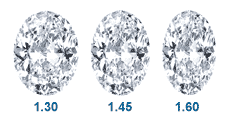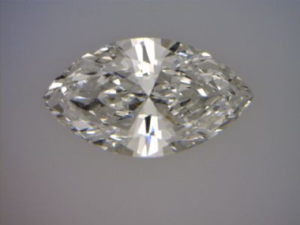
Oval diamonds
Oval diamonds are beautiful brilliant cut diamonds with a symmetrical elongated shape that gives an illusion of length and greater size on the hand. The slender shape can also make the finger of the wearer appear longer and slimmer, an effect often desired.
Oval diamonds often have a greater surface area than round diamonds of the same weight. For example, an average 1 carat oval diamond has a 10% larger surface area than an average 1 carat round diamond. This means that you can get a diamond that looks larger for a lower price.
The oval cut was created in the 1960s as an alternative to the round brilliant cut. Because the two shapes give a similar fire and brilliance, the oval is an ideal choice for a customer who likes the look of a round diamond but wants something more unique.
Oval cut diamonds are brilliant and fiery and reflect light beautifully. Like round brilliant cuts they usually have 58 facets but can vary slightly, with anywhere from 4 to 6 or 8 pavilion facets.
A greater length to width ratio means that oval diamonds will be longer and thinner, while a lower length to width ratio means the diamonds are more circular (a round diamond has a length to width ratio of 1).
Most people prefer oval diamonds with a length to width ratio from 1.3 to 1.7. Length to width ratio of 1.35 – 1.50 is considered the classic oval cut. However, there is no standard length to width ratio for oval cuts. They can be almost round, with a wider mid section and shorter length, or very long and lean.

Optimum Table & Depth for Oval Diamonds
| Ideal/Excellent | Very Good | |
| Table (%) | 53 – 63 | 52-53 or 63-64.8 |
| Depth (%) | 57.5 – 62 | 56-57.4 or 62-65 |
The Bow Tie Effect
Oval cut diamonds, like other fancy cuts such as marquise, pear and heart-shapes can display a bow tie effect: Black patches that resemble a man’s bow tie can be seen across the width of the diamond’s body. This effect is caused by imperfect proportions between the height, length and width of the rough diamond from which the stone is cut. Due to this imperfect structure, light leaks through the diamond’s pavilion, creating a dark shadow in the centre of the diamond from both girdles to the main belly facet.
Brilliant cut, or round diamonds do not get the bow-tie effect because they are perfectly symmetrical in shape and have an even distribution of light, as opposed to the fancy cuts where a shadow forms in the deeper parts due to imperfect reflection and refraction of light within the diamond. Ideally, a diamond should reflect every ray of light that enters through its table facet and back through it. However, not every stone is perfect and when we speak of diamonds with a poor make, we usually think of light leakage through the sides or the bottom of the stone.
The effect has varying levels and is noticeable even without a magnifying glass. If it is very dark the bow tie can significantly reduce the beauty of the cut diamond. However, bow ties are not necessarily all bad. A slight bow tie can actually give fancy shaped diamonds a certain appeal and define the diamond’s character. But a bow tie that is so prominent as to black out a large area of the stone is certainly not good.
When buying a diamond the bow tie effect is a little difficult to deal with because grading reports make no mention of it. The visibility of a bow tie effect cannot be ascertained by reviewing the diamond certificate or dimensions, but only upon visual inspection. There is no indication of whether a diamond displays a small bow tie or a large bow tie.
Since most online diamond distributors are unable to provide any visual assurance one has to be extremely careful when purchasing fancy cuts online. Visual inspection is the best way to accurately assess the extent of the bow-tie effect in a diamond. One can assess how obvious it looks from different distances as well as the effect it has on the diamonds overall brilliance and sparkle.
Generally, a slight bow-tie effect is rarely avoidable and is even considered a mark of top-notch cutting, where the cutter has been able to properly angle and proportion the facets, table and pavilion. In fact, fancy cut diamonds without any traces of bow-ties are usually cut to dismal proportions and have issues with brilliance.
In instances where the effect is substantial it could be the result of a flawed, improperly proportioned cut, and the complete absence of the effect could be as a result of a cut that is too shallow, with the attendant consequence of a marked decrease in sparkle.
Dark Black Triangles Obstruction

Pear

Marquise


Oval

Bowtie in Fancy Cuts Are Normal

Avoid diamonds with appearances like this!


